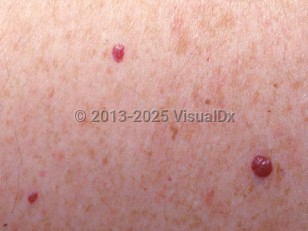Cherry hemangioma in Adult
Alerts and Notices
Important News & Links
Synopsis

Cherry hemangiomas (also known as cherry angiomas, Campbell de Morgan spots, and senile hemangiomas) are the most common type of acquired benign vascular proliferation and are composed of thin-walled, dilated capillaries. These growths often present in early to mid-adulthood and appear as small red or violaceous macules or papules that increase in number and incidence with age. Cherry hemangiomas are benign and thus do not require treatment unless irritated or bleeding (usually secondary to trauma), but are often of cosmetic concern to patients.
The etiology of cherry hemangiomas is still poorly understood, with evidence supporting either a reactive or a neoplastic underpinning. However, several recent studies examining the genetics of cherry hemangiomas provide strong evidence that they are benign neoplasms, as they frequently harbor mutations known to cause other types of tumors. Studies also suggest that hormonal influences may be involved, evidenced by spontaneous involution of lesions after pregnancy.
The strongest risk factor for cherry hemangiomas is age. However, studies have also identified associations between cherry hemangiomas and toxic exposures including mustard gas and bromide, and with a variety of more severe health conditions including melanoma, nonmelanoma skin cancer, noncutaneous malignancy, immunosuppression, and dyslipidemia.
The etiology of cherry hemangiomas is still poorly understood, with evidence supporting either a reactive or a neoplastic underpinning. However, several recent studies examining the genetics of cherry hemangiomas provide strong evidence that they are benign neoplasms, as they frequently harbor mutations known to cause other types of tumors. Studies also suggest that hormonal influences may be involved, evidenced by spontaneous involution of lesions after pregnancy.
The strongest risk factor for cherry hemangiomas is age. However, studies have also identified associations between cherry hemangiomas and toxic exposures including mustard gas and bromide, and with a variety of more severe health conditions including melanoma, nonmelanoma skin cancer, noncutaneous malignancy, immunosuppression, and dyslipidemia.
Codes
ICD10CM:
D18.01 – Hemangioma of skin and subcutaneous tissue
SNOMEDCT:
5050001 – Senile angioma
D18.01 – Hemangioma of skin and subcutaneous tissue
SNOMEDCT:
5050001 – Senile angioma
Look For
Subscription Required
Diagnostic Pearls
Subscription Required
Differential Diagnosis & Pitfalls

To perform a comparison, select diagnoses from the classic differential
Subscription Required
Best Tests
Subscription Required
Management Pearls
Subscription Required
Therapy
Subscription Required
References
Subscription Required
Last Reviewed:07/14/2020
Last Updated:07/29/2020
Last Updated:07/29/2020
 Patient Information for Cherry hemangioma in Adult
Patient Information for Cherry hemangioma in Adult
Premium Feature
VisualDx Patient Handouts
Available in the Elite package
- Improve treatment compliance
- Reduce after-hours questions
- Increase patient engagement and satisfaction
- Written in clear, easy-to-understand language. No confusing jargon.
- Available in English and Spanish
- Print out or email directly to your patient
Upgrade Today

Cherry hemangioma in Adult

